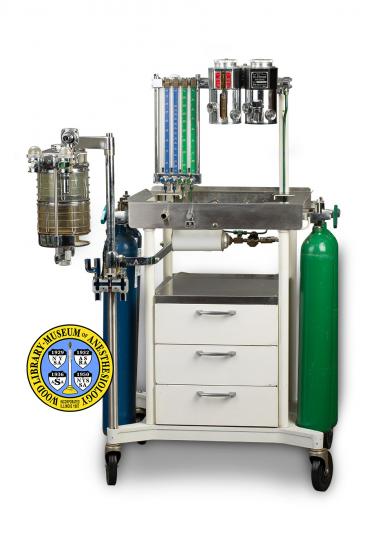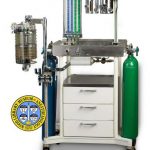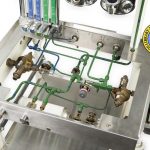Ohio Unitrol
Ohio Medical Products introduced the Unitrol Anesthesia Machine in the late 1960s. This was the last major development of the Heidbrink Kinet-O-Meter machine models, manufactured by Ohio since the late 1930s. In addition to the accessories common to all anesthesia machines, such as the vaporizer, ventilator and carbon dioxide absorber, the Unitrol's options included a fail-safe valve, gas supply alarm, and blood pressure monitor.
This example of the machine was dissected by Mr. Eddie Bowie, who worked for the Anesthesiology Department of the University of Chicago. He painted the gas lines blue and green to show how nitrous oxide and oxygen move through the machine. Mr. Bowie used his dissections of equipment for teaching purposes at medical schools and at meetings of the American Society of Anesthesiologists. The Unitrol stayed in production into the 1980s, when it was replaced by Ohio’s first fully-computerized machine, the Modulus.
Catalog Record: Ohio Unitrol
Access Key: alei
Accession No.: 2013-01-21-1
Title: Ohio Unitrol anesthesia machine / Ohio Medical Products.
Corporate Author: Ohio Medical Products.
Title variation: Alt Title
Title: Unitrol anesthesia machine / Ohio.
Publisher: Madison, Wisconsin : Ohio Medical Products, [between 1962 and 1988?].
Physical Descript: 1 anesthesia machine : metals, glass, plastics, rubber ; 130 x 112 x 63 cm.
Subject: Anesthesia Machines.
Subject: Anesthesia, Inhalation – instrumentation.
Note Type: General
Notes: The date range for the possible year of manufacture of this Unitrol is based
on an undated manuscript written by Jerry A. Dorsch titled, “Unitrol
Anesthesia Machine”. In this manuscript he reports the production dates for
the Unitrol Anesthesia Machine to be 1962-1988.
Note Type: Citation
Notes: Dorsch JA. Unitrol anesthesia machine [unpublished manuscript]. Company files
Located at: Wood Library-Museum of Anesthesiology, Schaumburg, Illinois.
Note Type: Physical Description
Notes: One anesthesia machine; The general measurements in the physical description
are based on the carbon dioxide canister swung, or pivoted, to the far left
of the machine (the viewer’s left); The table top is approximately 87 cm off
of the floor; Their machine has three drawers with an open area between the
upper drawer and the table top; There are two nitrous oxide yokes on the left
and two on the right; The upper portion of the yokes and connections to the
system are cut-away to aid a learner to better understand the pathway of
gases through the system; The table top is cut away so that the flow of gas
through the system and safety valves are visible; On the back bar above the
table-top are two flowmeters in blue for nitrous oxide and two flowmeters in
green for oxygen; A single agent Halothane vaporizer and a single-agent
Enthrane vaporizer are also on the back-bar; Portions of the front of these
vaporizers are cut away so that some of the inner-workings are visible; The
manufacturer’s plate for the machine is located on the upper right of the
back of the cabinet and is marked with, “Ohio Unitrol Anesthesia Machine”;
Also marked on this plate is stock number 216-6192-800, and serial number
ABDG0049; Also on the back of the machine are ports for wall-sourced oxygen
and a port for wall-sourced nitrous oxide; The large carbon dioxide absorber
is attached to a pole and can be pivoted into a number of positions; The top
of the absorber is marked, “Ohio Anesthesia Absorber” and has markings for
model number 210C, and Serial number ACKG00500; Instructions are also printed
on the top of the absorber; Valves for the breathing system located on the
pole have been cut away so that the function of the valves and flow of gas is
visible.
Note Type: Reproduction
Notes: Photographed by Mr. Steve Donisch, January 13, 2014.
Note Type: Acquisition
Notes: Donated to the WLM by by Mr. Eddie Bowie.
Note Type: Historical
Notes: The Unitrol Anesthesia Machine was introduced by Ohio Medical Products in
1962. It was the successor to the last models in the Kinet-O-Meter series.
Its initial design allowed for the incorporation of a Vernitrol vaporizer as
well as newer single-agent vaporizers, such as the halothane and Ethrane
vaporizers that are on the back-bar of the Unitrol described here.
According to anesthesia equipment expert, Jerry A. Dorsch, M.D., the Unitrol
was produced from 1962 to 1988, and was obsolete by 1994.
This machine was carefully dissected by Mr. Eddie Bowie of the University of
Chicago for use as a teaching aid. It was one of many instructional
‘cut-aways’ Mr. Bowie made, and donated to the WLM after his retirement.
Note Type: Publication
Notes: Craig DB, Longmuir J. Upgrading anaesthetic machines. Can Anaesth Soc J. July
1981;28(4):399. [Includes a table that summarizes upgrades performed on a
number of anesthesia machines.]
Note Type: Publication
Notes: Friesen RM, Hatton G. The upgrading and replacement of anaesthetic equipment:
a provincial approach. Can J Anaesth. 1991;37(8):889-895. [Summarizes
upgrades to a number of anesthesia machines, including the Unitrol.]



